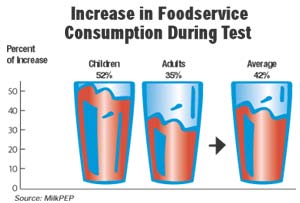
A recent foodservice test conducted by the Milk Processor Education Program (MilkPEP) measured response to five different types of promotions: the introduction of plastic pints and flavors, combo deals involving milk and things like cookies or donuts, children oriented promotions, and milk flavor straws, used to turn white milk into flavored milk, and adding milk to menus, menu boards, table tents, and other point of purchase material.
The results were impressive, with gains of at least 19% and several around 50%. One test, in upscale casual restaurants, even registered a 776% increase, albeit from a small base. On average, the tests yielded a 42% jump in milk sales.
“The results strongly suggest that milk is a beverage that restaurant-goers will order if they are reminded that it is an option,” says Tom Nagle, v.p. of marketing for the International Dairy Foods Association. This is good news since out-of-home eating dollars have surpassed money spent on in-home food purchases and this trend continues to grow.
“The milk industry has a golden opportunity to increase its current share of only 3%-5% of all beverages sold at restaurants,” he added.
According to the study, the increase potentially translates into a $300 million-$500 million of annual incremental milk sales across the four studied foodservice channels nationwide.
The research was conducted in 37 restaurants, including quick serve restaurants (e.g., Krystal Hamburgers, Krispy Kreme Donuts); midscale restaurants (e.g., Denny’s, Old Country Buffet); upscale casual restaurants (e.g., steakhouses); and cafeterias and delis in office buildings, plants, colleges and universities. The test took place in the summer and fall of 2002 for four to 10 weeks at each location.
The test analyzed the effectiveness of a variety of visual and vocal cues used by each restaurant and its staff to encourage customers to order milk. In-market promotions, point-of-purchase materials and servers or cashiers used verbal (suggesting ordering milk) or visual (such as “got milk?” apparel) reinforcement to encourage customers to order milk. The collected sales data was then reviewed. The data revealed that because milk is so under-promoted, almost any promotion is effective in increasing milk sales.
In the first two phases of the test, the Fluid Milk Strategic Thinking Initiative, MilkPEP’s think tank, studied the perceptions of processors, restaurant operators, and consumers about milk as a beverage option at restaurants. The third phase tested a variety of ideas that had arisen during phases one and two for selling more milk.
While sales for the in-market test saw sizable gains, even more encouraging was the 52% increase in sales when the promotions were geared toward children. In promotions where adults were the primary audience, milk sales rose 35%. This data suggests that, contrary to popular belief, adults will order milk if it is properly promoted.
At one location, parents who were surveyed reported that 94% of their children had ordered milk that day, and that previously 44% of their kids had never ordered milk in restaurants. More specifically, the study found that kids responded best to repetition in point-of-purchase materials and promotional items that can be taken home, such as stickers or temporary tattoos.
At Denny’s restaurants, a flavoring straw was very popular with children and was an easy way to add flavored milk to a restaurant’s menu. “Combo meal” deals were also effective sales tools, especially with kids and business and industry diners. The meal deals were most effective when the price was advertised on the promotional materials even if little or no discount was given. Changing the combo items teamed with milk at least every four weeks maximized sales, the study found.
Sales kits that will include a video, brochure and PowerPoint presentation to help processors grow their foodservice accounts will be available this summer.
Processors can request kits, once they are available, through the 800/945-MILK (6455) hotline. The full foodservice study will soon be available to processors on www.milkplan.org. For more information on the foodservice study, contact Liz Hodges at 202/220-3525 or at lhodges@idfa.org.